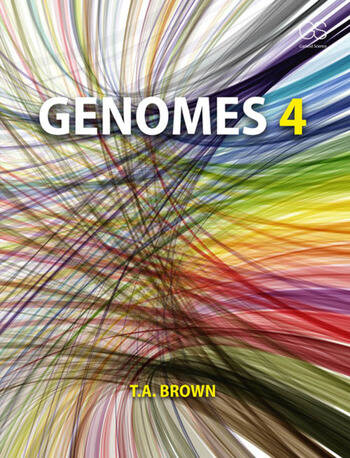
- GENOMES, 4th Edition
- Terry A. Brown, Manchester University
- Routledge, Taylor & Francis Group
-
ISBN: 9789925350599
- EVDOXOS ID: 112690937 (BROKEN HILL PUBLISHERS LTD)
| COURSE | BIOL473 - GENOMES |
| TYPE OF COURSE | Ellective (prerequisites: successful completion of BIOL207 MOLECULAR BIOLOGY) |
| YEAR | 4th-8th semester undergraduate Biology students |
| SEMESTER | Spring |
| CREDITS | 4 ECTS |
| DEPARTMENT | Biology, University of Crete |
| LECTURES | Biology Auditorium II, Friday 11:00-13:00 |
| COURSE COMPONENTS |
Lectures: Lecture slides are provided for each topic in the course. The lecture slides will be posted to Google Classroom site (Class code: jq7i3mo) following each lecture according to the course syllabus.
Essay: Weekly essays are 1-2 short questions after each lecture that cover the major highlights of each lecture and are spread across the period of the course. Essay responses for a lecture must be submitted via Google Classroom by 11:00am one week after the lecture is given. Exams: There is a final for this course: The exams will be 2 hours and will follow a format of short essay questions. The exams will focus primarily on material from the lectures. All exams of previous years will be posted on Google Classroom to guide the student about the format and type of questions of the exam. |
| GRADING SCHEME | 6 Essays x 5%=30%, Final Exam=70% |
| COURSE MATERIAL | In Google Classroom (class code: er4vfo3) you can have access to i. textbooks of the course, ii. Powerpoint presentations of the lectures, iii. pdf files of the lecture presentations, iv. previous exams questions & answers, v. Video files of ZOOM lectures, vi. educational videos. |
| COURSE DESCRIPTION | Genome sequencing and assembly methods discussed including a survey of four genome projects: human, Neanderthal, giant panda, and barley. Coverage of genome annotation emphasizes on genome-wide RNA mapping, with CRISPR-Cas 9 and GWAS methods of determining gene function. The knowledge gained from these techniques forms the basis of thelectures that describe the three main types of genomes: eukaryotic, prokaryotic (including eukaryotic organelles), and viral (including mobile genetic elements). Coverage of genome expression and replication is truly genomic, concentrating on the genome-wide implications of DNA packaging, epigenome modifications, DNA-binding proteins, non-coding RNAs, regulatory genome sequences, and protein-protein interactions. Also discussed are applications of transcriptome analysis, metabolomics, and systems biology. The final lecture is on genome evolution, focusing on the evolution of the epigenome, using genomics to study human evolution, and using population genomics to advance plant breeding. Established methods of molecular biology are included. |

Genomes, Transcriptomes and Proteomes
1.1 DNA
1.2 RNA and the Transcriptome
1.3 Proteins and the Proteome
Studying DNA
2.1 Enzymes for DNA manipulation
2.2 The Polymerase Chain Reaction
2.3 DNA cloning
Mapping Genomes
3.1 Why a Genome map is important
3.2 Markers for Genetic mapping
3.3 The Basis to Genetic mapping
3.4 Linkage analysis with different types of organisms
3.5 PhysicaL mapping by direct examination of DNA molecules
3.6 Physical mapping by assigning markers to DNA fragments
Sequencing Genomes
4.1 Chain-Termination Sequencing
4.2 Next-generation Sequencing
4.3 How to sequence a genome
4.4 a Survey oF eukaryotic genome sequencing projects
Genome Annotation
5.1 Genome annotation by computer analysis of the DNA sequence
5.2 Genome annotation by analysis of gene transcripts
5.3 Annotation by genomewide RNA mapping
5.4 Genome browsers
Identifying gene functions
6.1 Computer Analysis of Gene function
6.2 Assigning function by Gene inactivation and overexpression
6.3 Understanding Gene function by studies of expression pattern and protein product
6.4 Using conventional Genetic Analysis to identify Gene function
Eukaryotic nuclear genomes
7.1 Nuclear Genomes are contained in chromosomes
7.2 How are the Genes arranged in a Nuclear Genome?
7.3 How many Genes are there and what are their Functions?
7.4 The repetitive DNA content of eukaryotic Nuclear Genomes
Viral genomes and mobile genetic elements
9.1 The Genomes of Bacteriophages and eukaryotic Viruses
9.2 Mobile Genetic elements
Accessing the genome
10.1 Inside the nucleus
10.2 Nucleosome modifications and Genome expressIon
10.3 DNA modIfIcatIon and Genome expressIon
The role of DNA-binding proteins in genome expression
11.1 Methods for studying DNA-Binding Proteins and their attachment sites
11.2 The special features of DNA-Binding Proteins
11.3 Interaction Between DNA and its Binding Proteins
Transcriptomes
12.1 Components of the transcriptome
12.2 Synthesis of the Components of the transcriptome
12.3 Degradation of the Components of the transcriptome
12.4 Influence of RNA processing on the Composition of a transcriptome
12.5 Transcriptomes in research
Proteomes
13.1 Studying the composition of a proteome
13.2 Identifying proteins that interact with one another
13.3 Synthesis and degradation of the components of the proteome
13.4 Influence of protein processing on the composition of the proteome
13.5 Beyond the proteome
Genome expression in the context of cell and organism
14.1 The response of the Genome to external sIgnals
14.2 Changes in Genome activity resulting In cellular differentiation
14.3 Changes In Genome activity underlyIng development
How genomes evolve
18.1 Genomes: The first 10 Billion Years
18.2 Evolution of increasingly complex Genomes
18.3 Genomes: The last 6 million Years
18.4 Genomes Today: Diversity in populations